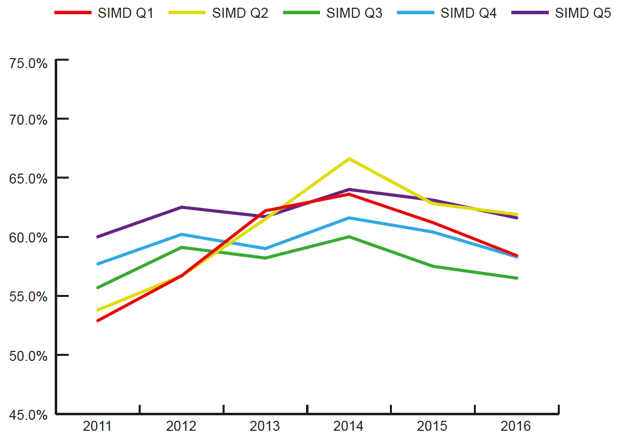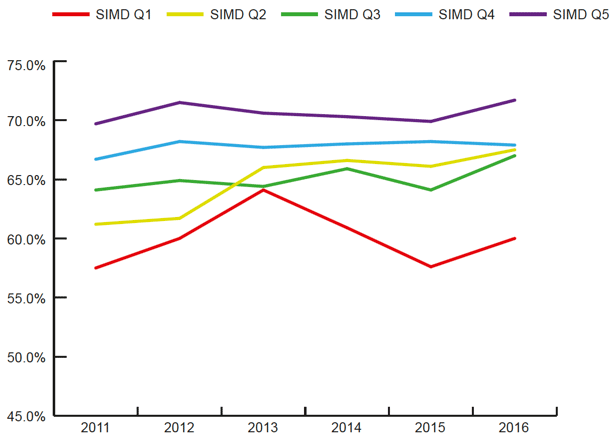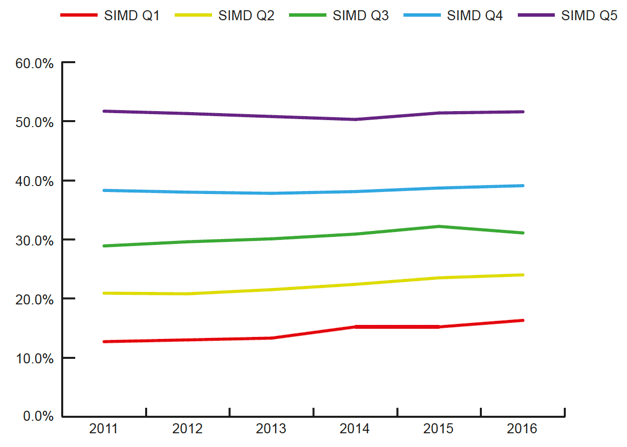Laying the foundations for fair access: annual report 2017 from the Commissioner for Fair Access
This is the first annual report from the Commissioner for Fair Access, covering the wider context of access to higher education in Scotland.
Chapter 3: Stimulating Demand
A major challenge is generating more applications from SIMD20 students. The evidence suggests that those who do apply generally receive a fair wind and, overall, are just as likely to receive offers (Chart 6) but slightly less likely to be placed at an institution (Chart 7) (Commissioner for Fair Access 2017). Although this does not indicate that universities are actively discriminating against SIMD20 students, it does suggest there may be unconscious patterns of bias - in contrast, SIMD20 students are overrepresented in colleges). The major deficit, however, continues to be the initial shortfall in applications (Chart 8). Clearly this needs to be forcefully addressed. Otherwise there is likely to be growing competition between universities to recruit from a limited pool of SIMD20 to meet targets, possibly with negative effects if students are diverted from post-1992 universities with a strong commitment to, and long experience of dealing with, students from more deprived backgrounds to universities that may lack their experience (or even commitment).
Chart 6: Offer rate by deprivation quintile ( SIMD1 = SIMD20), 2011 to 2016
Source: UCAS

Chart 7: Acceptance rate by deprivation quintile ( SIMD1 = SIMD20), 2011 to 2016
Source: UCAS

Chart 8: Application rate by deprivation quintile ( SIMD1 = SIMD20), 2011 to 2016
Source: UCAS

Outreach and bridging programmes
One of the most powerful instruments for increasing the proportion of SIMD20 applicants has been the use of bridging programmes of various types. Most, as the label 'bridging' suggests, are summer schools. Often a condition attached to an adjusted, i.e. lower, offer is attendance at a summer school. Typically the detailed curriculum of these schools focuses on study and research skills, academic writing and subject-specific gaps in academic knowledge (notably mathematics), although most also attempt to provide a more general introduction to student life. There are many examples of good practice. In addition to summer schools some universities seek to make earlier interventions, from the middle years of secondary school back even as far as the last years of primary school. Again there are many examples of good practice.
Bridging programmes were one of the three topics covered in the recent Universities Scotland report on widening access (Universities Scotland, 2017). The other two were articulation and admissions (which are discussed below). The report is based on three work streams identified for action by US in its response to the report of the Commission on Widening Access. The work stream on bridging programmes identified four actions:
1. The need for improved 'national coherence', including improved regional coordination and, where possible, mutual recognition;
2. The scoping of an online resource that will enable applicants, parents and schools to access all the relevant information about bridging programmes in Scotland in one place;
3. The adoption of a common language and terminology to describe bridging programmes - again to make what is on offer more accessible to applicants, parents and schools;
4. Consideration of the potential for introducing regional access targets to encourage collaboration, alongside institutional and national targets.
Welcome as these actions are, they may not be sufficient to produce the step-change that is needed.
- First, the scale of bridging programmes needs to be increased. For understandable reasons many are relatively small-scale; applicants less familiar with universities clearly benefit from a personalised approach within small groups. However, imaginative ways need to be found to increase the volume of students on bridging programmes without destroying the necessary intimacy.
- Secondly, and for similar reasons, most bridging programmes offer customised provision, focused on the detailed needs of potential applicants from the deprived communities targeted by individual universities. However, an analysis of the content and curriculum demonstrates a broad consistency of subject matter. It should be possible to identify generic content that could be common across Scotland while allowing institutions the scope to include more specific material. A version of this core-customised provision model is the approach recommended by the US work stream on admissions with regard to indicators to be taken into account in making adjusted offers (see below). It would make it easier to move towards the mutual recognition of bridging programmes across Scotland. Although the majority of SIMD20 applicants will attend their local university, barriers to the portability of credit earned from attending bridging programmes should be reduced to the minimum.
- Thirdly, it is important to take a holistic view of all the initiatives and interventions made by universities (and by foundations such as the Robertson and Sutton Trusts) to increase the supply of SIMD20 applicants. Bridging programmes come late in the cycle of potential interventions. Although they are successful in transforming opportunities for already motivated SIMD20 applicants with reasonable levels of attainment, they are less likely to be successful in shifting more deeply-entrenched attitudes towards who should benefit from higher education (among applicants themselves, their parents and, possibly, their teachers). Earlier interventions, ideally involving parents and families, may be more effective in this more difficult task. So it is important that bridging programmes are regarded as only one element within a wider array of interventions. In this respect the Commission on Widening Access made a number of relevant recommendations about engagement with younger learners and their families.
- Finally, there is a danger that the idea of introducing regional targets floated in the report could dilute overall responsibility for meeting institutional and national targets, although it makes sense to organise some outreach activities, including summer schools, on a regional basis. The necessary task of monitoring the effectiveness of these activities should not be confused with the responsibility of institutions for meeting fair access targets.
In brief, there is a need to 'scale up', by increasing the volume of applicants who can benefit from bridging programmes, and 'join up', in two senses - the mutual recognition, and the portability, of credit earned by attending bridging programmes identified in the US report; but also regarding bridging programmes as one element within a package of multiple interventions. In this respect the development of a Framework for Fair Access, a web-based resource to categorise and help evaluate the effectiveness of these interventions, will be a significant step forward. This development is currently being overseen by a representative group chaired by Conor Ryan, Director of Research and Communications at the Sutton Trust, which is expected to report in the spring. The aim is to produce an instrument in which best practice can be identified, and shared, without inhibiting the development of imaginative new models.
A new social covenant?
The wider context also needs to be taken into account. Even if bridging programmes are scaled-up and joined-up, the overall pattern of (un)fair access will remain. But it is not acceptable to wait for a social revolution that will miraculously reduce inequalities of wealth and disparities in life-chances to 'self-generate' more applications from SIMD20 areas (as has already been indicated, recent trends have been to greater inequality). A major responsibility lies with schools, and it is among the most urgent priorities of the Scottish Government to address the attainment gap. But, once again, there can be no instant or magical solution. Attainment gaps are rooted in aspiration gaps, which in turn reflect, all-too-accurately, perceptions of life-chance disparities. For learners from more prosperous homes aspiration is easy; for learners from more deprived backgrounds it is more difficult to generate. Also care needs to be taken that attainment is not simply measured in terms of too narrowly conceived benchmarks; the optimal learner pathway, in terms of stages and formal achievements, is still determined by reference to traditional middle-class patterns.
Higher education, and in particular the most highly regarded universities, has a key leadership role. That leadership must be exercised in several different ways. It is not confined to developing more access-friendly admissions policies (which will be discussed later in this report). Interventions at this, comparatively late, stage will only be successful in attracting the already motivated among teenagers from deprived areas, who are also likely to have overcome significant obstacles (and may have achieved qualifications at, or close, to those required for university entrance). Access-friendly admissions policies send important cultural messages that will have longer-term effects however. In the same vein summer schools and other forms of bridging programmes, however necessary, will also tend to target a motivated minority of potential applicants from deprived areas. Most institutions now recognise the need for earlier interventions, crucially in the earlier years of secondary education when key subject choices are made and even in the final years of primary school. There can also be powerful synergies between adult learning and fair access for young people, opening up the possibilities of multiple initiatives focused on families and whole communities. Empowered parents will have much higher expectations of their communities.
A new 'social covenant' may be needed between higher education and the nation, and their communities that seeks to 'join up' the multiple interactions between institutions and their stakeholders. Such a covenant should cover the widest possible range of interventions and interactions. The education of school teachers eager to meet the challenges posed by disparities in aspirations and therefore attainment (in Scotland teacher training remains a university monopoly - for the moment); the provision of adult and lifelong learning to address past deficits and discrimination; research with real social impact (and often active community engagement) as well as research producing economic benefits - all these complement and strengthen fair access policies. The articulation of such a new 'social covenant', and the adoption of a holistic approach, could help to generate more applications from SIMD20 areas by shifting deep-rooted, and not entirely unjustified, perceptions of universities. This would not need to be yet another bureaucratic instrument to be signed off, approved against formal criteria and then monitored. Rather a new social covenant could be a summation of an institution's engagement with its communities, and with the wider nation.
Contact
There is a problem
Thanks for your feedback